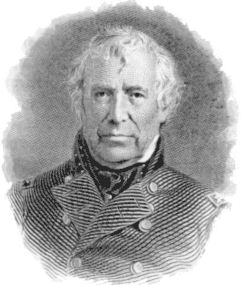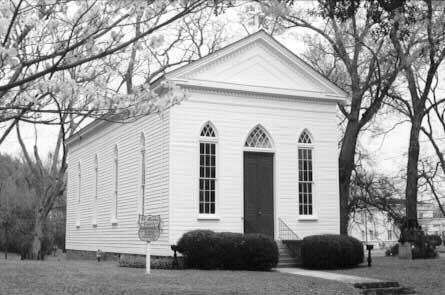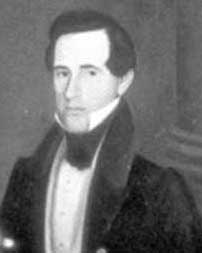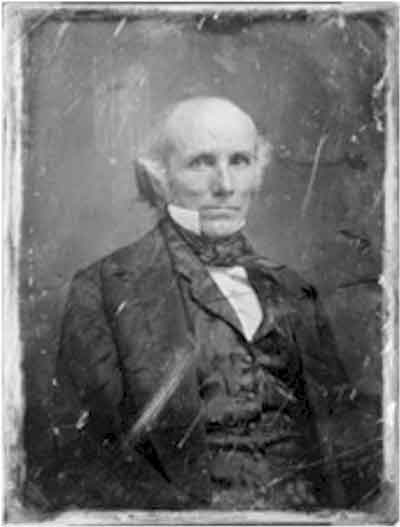"Raymond Years Ago"
By George W. Harper
Journalist - Editor - Owner Of Hinds County Gazette 1845-1883
A Series Published in the Hinds County Gazette, 1878-1879
From the Gillespie Collections edited by Pattie Adams Snowball and Rebecca Blackwell Drake
Home Page
Harper Arrives in Mississippi
Vicksburg & Meridian RR
Businesses in 1844
The Raymond Bar
Early Merchants
1844 Businesses
Seat of Justice
Cotton Industry
Early Churches
Establishment of Schools
John B. Peyton
Raymond Area Homes
Medicinal Resorts & Spas
The Mexican War
Early Churches
Early Schools
Raymond Female Institute
Raymond Military Institute
McNutt-Foote Debate
1844 Presidential Election
Local Elections of 1845
Literary Raymond
Raymond Fires
Old Log Jail
Death of Jos. Stewart
Murder of Benj. Sims
Duel Ends in Death
Raymond & Bolton RR
Harper Elected Mayor
Chaos at Oak Tree Hotel
Great Fire of 1858
Early Area Settlements
-
Amsterdam
-
Yeizer's Store
-
Newtown
-
Meridian Springs
-
Sturgiss Store
-
Dry Grove
-
County Line
Rev. Fisk's Biology Class
Fisk Charged with Fraud
Fleetwood Tragedy
Local Racetracks
Dignitaries Visit Raymond
Winning the Lottery
Fire Company No. 1
"Devoted & Valued Friend"
Tribute to Amos Johnson
Yellow Fever Strikes Raymond
Doctors Treating Victims
Cooper's Well
Mississippi Springs
Newspaper Entrepreneurs
Yankees Sack Gazette Office
Fate of Editorial Giants
Henry Clay Defeated in 1844
Stray Cats in Raymond
"A Remarkable Occurrence"
Blow That Punky Bell to Hell"
Isom Bldgs Destroyed
1851 Gubernatorial Election
Union Ticket Sweeps State
New Raymond Courthouse
Gibbs Building Rebuilt
Hinds Co. Poor House
Schools Struggle
Murder of Addie Owens
War comes to Raymond
The Battle of Raymond
Willie Foote Captured
Make-shift Hospitals
Yankees Occupy Raymond
Raymond Lodge No. 21
Odd-Fellows' Graveyard
Bolls Incarceration
Crimes Blamed on Whisky
Peyton's Willow Tree Prank
Politics in Raymond
Presidential Election 1860
Hinds Co. for Succession
Raymond Fencibles Organized
Churches Reorganize
The Clinton Riot of 1875
Why the Great Uneasiness?
Deaths of Sivley & Thomson
"Kill the Raymond Men"
Harrison Election
Political Gatherings
Event at Dupree's Grove
Presidential Election 1876
Governor Ames Impeached
Great Wrongs Investigated
Fight the Devil with Fire
Reconstruction Era
Harper Ends with Poetic Vision
Part IV
The Mexican War
|
|
When news was received in Raymond, in 1846, that Gen.
Taylor’s little army on the Rio Grande was surrounded by the Mexicans, and that
it was probable that the 1,500 Americans under Taylor might be cut to pieces by
the 20,000 Greasers, a most intense enthusiasm in behalf of the American flag
was exhibited. A meeting was immediately held at the old court house, at which
Maj. Peyton, presided, and Geo. W. Harper, acted as secretary, and at once a
full company of volunteers for twelve months was enrolled, and with all haste it
was prepared for the field. R. N. Downing was elected captain, S. A. D. Greaves
first Lieutenant, and W. H. Hampton second Lieutenant. The enrollment continued
for some days, and when the company reported at Vicksburg there were 110 members
- about 25 of whom had to be sent back home, as the U. S. laws allowed the
companies to consist of but 85 men each. The company on leaving Raymond for
Vicksburg was accompanied by the citizens, (ladies and gentlemen,) almost in a
body - the company marching, the citizens on horseback and in conveyances - to
Clinton, where a public dinner was given to all in attendance.
 The company
became a part of the 1st Mississippi Regiment, Jeff. Davis, colonel, A. K. McKlung, lieutenant-colonel, and A. B. Bradford, major, and was in all the
battles of northern Mexico under Taylor, and covered itself with imperishable
renown. Capt. Downing was severely wounded at Monterey, and both there and at
Buena Vista many of the men were wounded and others killed. The remnant of the
company was welcomed home at the close of the war - after an absence of about a
year - with great rejoicing. They were met at Clinton - escorted to Raymond, and
everything was free to them for weeks. At the next election, 1847, Capt. Downing
was elected sheriff of the county and Lieut. Hampton, probate clerk.
The company
became a part of the 1st Mississippi Regiment, Jeff. Davis, colonel, A. K. McKlung, lieutenant-colonel, and A. B. Bradford, major, and was in all the
battles of northern Mexico under Taylor, and covered itself with imperishable
renown. Capt. Downing was severely wounded at Monterey, and both there and at
Buena Vista many of the men were wounded and others killed. The remnant of the
company was welcomed home at the close of the war - after an absence of about a
year - with great rejoicing. They were met at Clinton - escorted to Raymond, and
everything was free to them for weeks. At the next election, 1847, Capt. Downing
was elected sheriff of the county and Lieut. Hampton, probate clerk.
S. B. Thomas, B. F. Edwards and Joshua Stone are the only members of the company that we can now call to mind who are living in this town or vicinity.
Early Churches
As we have before said, there was but one church edifice in Raymond when we came here in 1844 - the Methodist, the Baptist, the Disciples, the Presbyterians, and the Episcopalians had occasional services, however, occupying at various times the Methodist church, the court house, the Female Academy and the Brick Academy.
|
|
The Methodist church edifice was erected in 1834. The next church built was the Baptist, under the ministerial services of Dr. R. Warner, about the year 1845. Then came the Episcopal church in 1852 and the Presbyterian in 1870. The original Baptist church was built of brick, and was peculiarly constructed. Soon after the war, in making some changes in the interior arrangements of the building, a pillar was removed, when, without warning to the half dozen persons who were within the walls, the whole building fell with a tremendous crash. Most providentially and mysteriously, no one was killed, but two or three persons - - among them one lady - were injured. In 1869 or ’70 the neat frame building now occupied by that denomination was erected on the site of the old brick edifice.
The lot on which the church stands was a private garden, belonging to Amos R. Johnston, when we came to Raymond in 1844. Judge Johnston donated it, we believe, to the Baptist denomination for church purposes. Where the Presbyterian Church stands, was for many years the site of a large and well appointed livery stable, occupied by A. J. Johnston, whose widow died with fever at Dry Grove in October last. Where the Episcopal church stands, formerly stood the private residence of Thomas Smith, who was one of the earliest settlers of the town, and carried on the shoe-making business until his death, which occurred about 1852. Mr. Smith was one of the marked characters of the town, and left several children. One of his daughters was the wife of W. R. Clark, who died with yellow fever near the town in October, his wife and children dying about the same time near Baldwin’s Ferry.
Early Schools
In 1844 the Brick School House was still standing, on the southwest borders of the town, near what is known as the Odd-Fellows Graveyard. This was among the first building erected in Raymond, and dates back previous to the year 1834; for in that year, according to the late Rev. Thomas Ford, he there organized the First church known to Raymond, (the Methodist,) and first Sunday School. There were several efforts made, from 1844 to 1862, to establish a creditable Male School in this building, but they all failed - the nearest to success being while it belonged to the Masonic Lodge and was under its control. The Lodge, we believe, expended about $1,500 in trying to build up the School, and then through exhaustion let it fall. Capt. J. C. Davis was for sometime the head of the school. The last effort to keep the school afloat was made by Mr. Thompson, a highly educated gentleman from Vicksburg. He carried the school along for some months, but Grant’s army appearing before the town, (May 1863) he abandoned it and left the town. This closed the Brick School House as an educational locality. Some years after the war the building was torn down, or fell down, and now not one brick stands upon another to show where it once stood.
Raymond Female Institute
About the time that the Mississippi Military Institute was removed to Raymond (1848), A. Hannum with several lady assistants, established what was known as the Raymond Female Institute.
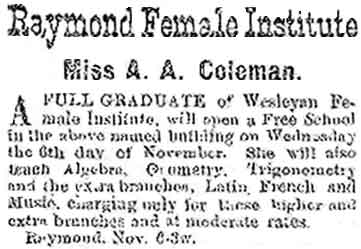 It started with very favorable prospects, and Mr. Hannum
purchased the property where Mrs. Ellen Gibbs now resides, and erected the large
and commodious school building now there in a dilapidated state. The Institute
was a decided success, having more than a hundred pupils, and from 30 - 40
boarding pupils. In 1852 or ’53, however, the patronage fell off, and Mr. Hannum
becoming peculiarly involved, he closed the establishment and moved away. Mrs.
McLane, who was a sister of Mr. Hannum, was for a time an assistant in the
Institute - the same Mrs. McLane who became a Mormon, and fleeing from New
Orleans with a Mormon Elder, was overtaken by her husband at Fort Smith,
Arkansas, when the injured husband slew the Mormon Elder - and from this, it is
said, followed the great massacre by the Mormons at Mountain meadows, and for
leading, which Gen. J. D. Lee was recently tried, condemned and hung in the
northwest.
It started with very favorable prospects, and Mr. Hannum
purchased the property where Mrs. Ellen Gibbs now resides, and erected the large
and commodious school building now there in a dilapidated state. The Institute
was a decided success, having more than a hundred pupils, and from 30 - 40
boarding pupils. In 1852 or ’53, however, the patronage fell off, and Mr. Hannum
becoming peculiarly involved, he closed the establishment and moved away. Mrs.
McLane, who was a sister of Mr. Hannum, was for a time an assistant in the
Institute - the same Mrs. McLane who became a Mormon, and fleeing from New
Orleans with a Mormon Elder, was overtaken by her husband at Fort Smith,
Arkansas, when the injured husband slew the Mormon Elder - and from this, it is
said, followed the great massacre by the Mormons at Mountain meadows, and for
leading, which Gen. J. D. Lee was recently tried, condemned and hung in the
northwest.
Raymond Military Institute
In 1847 Col. Goldsborough, claiming to be from Alabama and a graduate of West Point, opened at Mississippi Springs what was known as “Mississippi Military Institute.” Col. G. was a tall, fine-looking man, had a military bearing, and was an agreeable conversationalist. He received a flattering support from the surrounding counties, and very soon the Institute had over one hundred cadets. Some difficulty occurring between the owners of the property and the Colonel, in 1849 he proposed to the citizens of Raymond that he would remove his Institute to this town if the citizens would furnish him with proper building, he to pay 10 per cent interest on the amount of their cost. A joint stock company was soon formed, with a capital, we believe, of $8,000 or $10,000, for the purpose of establishing the Institute at Raymond. The John A. Fairchild property, (40 acres), about one mile southeast of the town was purchased and at once was erected an immense frame building, with all the conveniences for a Military Institute, with a boarding department, professors’ houses, superintendent’s house, parade ground, &c., and soon the Institute was in successful operation, with a full faculty, and a number of cadets exceeding all expectations.
Col. Goldsborough suddenly started for Alabama or Florida; we do not now remember which, for his family. He overstaid [sic] his time - weeks ran off - and no Col. Goldsborough - nor was he hear from. Creditors became uneasy, and commenced pushing their claims on the Colonel’s personal effects. At length all hope for his return vanished, and the Institute was taken possession of by Messrs. Gibbons and Vernon, two of the faculty, who proposed to run it, but in their hands it immediately went down, in numbers, to a neighborhood school. Col. Goldsborough, it was said, reached Vicksburg about the time Gibbons and Vernon assumed control, and was so discouraged that he returned to Florida, where he was accidentally drowned some years after. In 1850 the Institute was purchased by Prof. Dimitry, of Louisiana, a gentleman of splendid attainments and wide reputation. He had a fine school for a year or two, but the patronage not meeting his expectations, he returned to New Orleans in 1853. Capt. J. C. Davis then tried the school for a time, but abandoned it, perhaps, within a year - when the Mississippi Military Institute died. The property in time passed into the hands of Mr. Geo. W. Gibbs, and a few years ago was destroyed by fire - and there was an end of it.
The building now known as the “old Magnolia House,” was not standing in 1844. In the centre of the lot, however, Isaac Clifton had a small frame building, in which he carried on the cabinet making business. By degrees he added to his shop, on the wings and in front, until he brought the building to the street, and extended it to its present dimensions. He planted around the building numerous orange trees, and named the edifice Orange Grove House. In a year or two, however, a biting and nipping frost came which killed all the orange trees, but left a thrifty magnolia on the south side. The place then took the name of Magnolia House, which name it bears to this day, though the tree is now dead. For some years, the house was occupied as a hotel, but of late years, as the property of Jos. Gray, it has been used for business purposes. Mr. Clifton left Raymond in 1854 a poor man and lived for some time at Crystal Springs and died years ago in one of the counties south of Hinds. He was originally from Tennessee.
1845 Campaign for U.S. Senate: McNutt vs. Foote
|
|
The first political speech we heard in Raymond was delivered in the old court house in 1845 by Ex-Gov. McNutt. He was then a candidate “before the people” for the United States Senate. He claimed to be the father of the Democratic party of Mississippi - claimed the honor of being the first “Repudiator,” and the man who carried that flag to victory. He was replied to by Gen. H. S. Foote, of the same party, who was also a candidate for Senator, and who we then heard for the first time.
|
Foote’s speech contained lightning, thunder, rain and hail, and such an excoriation we never before listened to. McNutt did not remain in the court house to hear it, but smelt it from the bar room across the street, and treated it as a fine joke. Foote followed McNutt all over the State, and to the surprise of now a few, when the Democratic Legislative caucus was held; Foote beat McNutt for the nomination, which nomination was subsequently confirmed by his election.
NOTES
Mr. F. A. R. Wharton informs us that we were wrong in placing the postoffice in Professional Row in 1844. He reminds us that there was a small one-story frame building between the Shearer building and Professional Row, (long ago removed,) and that it was in the small frame house that D. Peyton Harrison kept the postoffice.
In our list of merchants in the town in 1844, given in a former number, we accidentally omitted the name of C. Vanderpool. Mr. Vanderpool remained in Raymond until 1854 or ’55, when he removed to Sunflower Landing. If still living, we are not advised as to his place of residence.
All photographs, drawings and illustrations were edited into the series by Pattie Snowball and Rebecca Drake.
Copyright © 2008 Pattie Adams Snowball, James and Rebecca Drake
